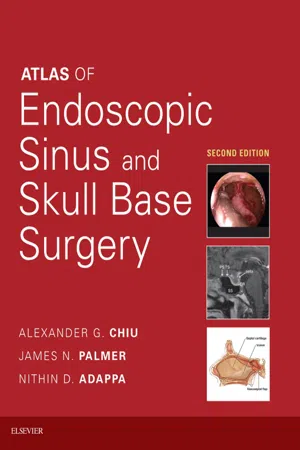
Atlas of Endoscopic Sinus and Skull Base Surgery E-Book
- 368 pages
- English
- ePUB (mobile friendly)
- Available on iOS & Android
Atlas of Endoscopic Sinus and Skull Base Surgery E-Book
About this book
Gain a clear understanding of the entire spectrum of today's rhinology and anterior skull base surgery with Atlas of Endoscopic Sinus and Skull Base Surgery, 2nd Edition. This thoroughly updated title increases your knowledge and skill regarding both basic or advanced procedures, taking you step by step through endoscopic approaches to chronic sinus disease, nasal polyps, pituitary tumors, cerebrospinal fluid leaks, sinonasal tumors, and more.- Covers the full range of modern rhinology and anterior skull base surgery, from septoplasty and sphenoethmoidectomy to extended frontal sinus procedures, endoscopic craniofacial resections and complex skull base reconstructions.- Clearly conveys the anatomy and detailed steps of each procedure with concise, step-by-step instructions; visual guidance features high-definition, intraoperative endoscopic photos paired with detailed, labeled anatomic illustrations.- Features all-new videos expertly narrated by Dr. Palmer and Dr. Chiu.- Includes new content on anterior skull base surgery that reflect new developments in the field.- Helps you provide optimal patient care before, during, and after surgery with detailed information on relevant anatomy and surgical indications, instrumentation, potential pitfalls, and post-operative considerations.- Expert Consult™ eBook version included with purchase. This enhanced eBook experience allows you to search all of the text, figures, and references from the book on a variety of devices.
Frequently asked questions
- Essential is ideal for learners and professionals who enjoy exploring a wide range of subjects. Access the Essential Library with 800,000+ trusted titles and best-sellers across business, personal growth, and the humanities. Includes unlimited reading time and Standard Read Aloud voice.
- Complete: Perfect for advanced learners and researchers needing full, unrestricted access. Unlock 1.4M+ books across hundreds of subjects, including academic and specialized titles. The Complete Plan also includes advanced features like Premium Read Aloud and Research Assistant.
Please note we cannot support devices running on iOS 13 and Android 7 or earlier. Learn more about using the app.
Information
Septoplasty
Introduction
- ▪ The nasal septum plays a key role in the form and function of the nose, nasal cavity, and paranasal sinuses.1
- ▪ Septal deformities are common and occur in nearly 77% to 90% of the general population worldwide.2,3
- ▪ Even small deviations in key areas have been shown to adversely affect nasal airflow, delivery of nasal medications, mucociliary clearance, and the external appearance of the nose.4–6
- ▪ Improving nasal airflow continues to be the primary goal of nasal septal surgery. Other indications include epistaxis, sinusitis, obstructive sleep apnea, and headaches.5
- ▪ This chapter focuses on three commonly used septoplasty techniques: traditional septoplasty performed with a headlight; septoplasty addressing caudal deformities; and endoscopic septoplasty, both for diffuse deflections and the directed endoscopic septoplasty approach, to address focal septal deviations (spurs).
Anatomy7–9
- ▪ The nasal septum is a mucosa-covered bony and cartilaginous structure located in the rough midline of the nose, which separates the right nostril from the left nostril (Fig. 1.1).
- ▪ The nasal septum is situated in a sagittal plane extending from the skull base superiorly to the hard palate inferiorly and the nasal tip anteriorly to the sphenoid sinus and nasopharynx posteriorly.
- ▪ The bony portion of the septum includes the perpendicular plate of the ethmoid bone, the vomer, and the maxillary crest, which has contributions from the maxillary and palatine bones. The quadrangular cartilage forms the caudal portion of the septum.
- ▪ At the junction of the osseous and cartilaginous portions of the septum, the perichondrium and periosteum are not contiguous. Between the two layers are dense decussating fibers.
- ▪ The nasal septum forms the medial wall of each nasal cavity and contributes to the internal and external nasal valves.
Preoperative Considerations
- ▪ Patient history is important in establishing an operative plan. Preoperative history taking should elicit information regarding subjective nasal airway obstruction, prior trauma, epistaxis, nasal decongestant use, and drug use.
- ▪ Adequate mucosal decongestion and vasoconstriction are essential in reducing intraoperative bleeding and optimizing visualization during the procedure.
- ▪ Endoscopic examination prior to surgery is a valuable adjunct to anterior rhinoscopy to completely examine the nasal septum and allow accurate identification of the location and severity of a septal deviation.10
- ▪ Choice of septoplasty technique should be based on the nature and location of the deformity; patient history, including prior septoplasty; and surgeon skill and preference.11
Radiographic Considerations4,12
- ▪ Radiographic evaluation is not necessary to diagnose a septal deviation prior to surgery but is often available when septoplasty is performed in conjunction with other rhinologic procedures.4
- ▪ When available, coronal computed tomographic (CT) scan of the sinuses is the preferred study to evaluate the course of the nasal septum (Fig. 1.2).

Fig. 1.1 Drawing of the nasal septum in the sagittal view. 
Fig. 1.2 Coronal computed tomographic scan of the sinuses demonstrating a large posterior septal deformity. - ▪ The coronal CT scan may assist in identifying posterior deflections not visualized on anterior rhinoscopy or other sources of nasal obstruction, such as a concha bullosa.
- ▪ Despite its value, a CT scan may not accurately demonstrate the degree of septal deviation evident on physical examination.
Instrumentation (FIG. 1.3)
- ▪ Nasal...
Table of contents
- Cover image
- Title page
- Table of Contents
- Copyright
- Dedication
- Contributors
- Preface
- Video Contents
- Part 1. Nasal Surgery
- Part 2. Basics of Primary Endoscopic Sinus Surgery
- Part 3. Revision Endoscopic Sinus Surgery for Inflammatory Disease
- Part 4. Orbital Surgery
- Part 5. Sinonasal Tumors
- Part 6. Skull Base Reconstruction
- Part 7. Anterior and Central Skull Base Approaches
- Part 8. Combined Endoscopic and Open Approaches—Frontal Sinus
- Index